
Positioning Equipment: Enabling Technology for Life Sciences
Industry experts offer an inside look at the current state of positioning technologies for bio-related microscopy.
Positioning systems and equipment are sometimes the unsung heroes of microscopy: Users often focus more on the optics and the light sources than on the devices that keep the rest of the system stable enough for death-defying feats of resolution and imaging depth. But that stability is vital – without it, further advances in biological research might not be possible.
BioPhotonics reached out to major players in the industry to gain some insight into how the positioning market is doing at present and where it’s going in the future. The company reps we interviewed were: Stephan Briggs, a biomedical engineer at Edmund Optics in Barrington, N.J.; Alexandra Cooper, director of sales and marketing at Sutter Instruments in Novato, Calif.; Robert S. Hodge, president of Siskiyou Corp. in Grants Pass, Ore.; Malcolm Minty, general manager at New Focus in Santa Clara, Calif.; Stefan Vorndran, vice president of marketing at PI (Physik Instrumente) LP in Auburn, Mass.; and John Zemek, executive director of ASI/Applied Scientific Instrumentation Inc. in Eugene, Ore.
Q: What do you see as the “next big thing” in positioning for bio? Are you seeing any new and exciting advances coming out of R&D and/or university labs?
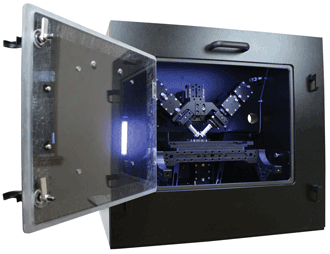
ASI’s diSPIM (dual inverted selective-plane illumination microscopy) system was developed in collaboration with Dr. Hari Shroff of the NIH/NIBIB. Courtesy of Applied Scientific Instrumentation.
Zemek: Superresolution microscopy and selective-plane light-sheet microscopy are the next big thing. The superresolution scopes require very stable positioning stages, and the light-sheet scopes require precise positioning control of a number of axes, including syncing the positioning of the laser/light-sheet position via micromirrors with the imaging objectives that are mounted on piezos.
We have been working with Dr. Hari Shroff at the NIH/NIBIB (National Institute of Biomedical Imaging and Bioengineering) for the last few years to develop a dual inverted selective-plane illumination microscopy (diSPIM) system. This system is 30 times faster than standard confocal systems and is very efficient with photons, so there is very little photo-bleaching or phototoxicity. This makes it a perfect system for long-term live-cell experiments.
Hodge: High-resolution 3-D imaging is really the latest big thing and is the combination of photonics and the life sciences coming together.
The next step will be to integrate that technology into commercial application, and will require highly precise and stable mechanical devices (optics mounts, linear stages and motorized drives) to enable consistent day-in, day-out operation that is demanded at the commercial level.
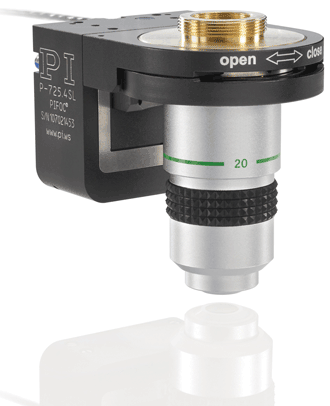
Piezo-based nanofocus devices such as the PI PIFOC are often used in superresolution microscopy, fluorescence microscopy, drug discovery and 3-D imaging. Courtesy of PI (Physik Instrumente) LP.
Minty: We see a move to more benchtop instruments that have a more compact optomechanical layout. This often requires integrated precise, remote adjustments that were previously done by manual stages or mounts.
Vorndran: Microscopy, sequencing and screening applications have a higher demand for throughput and precision at the nanometer level. Nanopositioning devices are used in fast nanofocusing, beam-steering and 3-D cell imaging applications. Nanodispensing – extremely precise dosing of liquids based on precision motion control at the nanometer level – also becomes more important in drug discovery applications.
Briggs: Actuators and motorized stages for biomedical and life sciences applications … are still expensive. Once the price comes down, I expect more to be integrated into systems and applications at the research and production level.
Cooper: Mechanically, we see improvements in positioner design made possible by higher-accuracy five-axis machining centers. Tighter tolerances make for higher precision in the instrument. The biggest changes are not mechanical: Better user interface designs and tighter integration with imaging and data acquisition software are making positioning products easier to use.
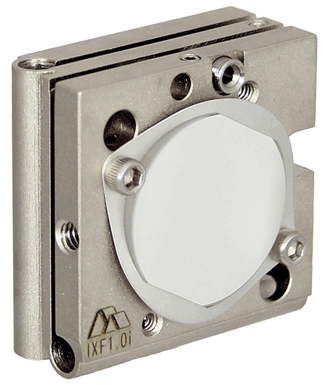
Siskiyou Corp. offers mounts such as the IXF10i, seen here with clip, and also offers DC servo drives and high-resolution adjustment screws. Courtesy of Siskiyou Corp.
In bio, we were excited about the implementation of the first imaging-based brain-machine interface using two-photon calcium imaging, which paves the way for paralyzed patients to directly control devices (e.g., wheelchairs, robot arms, computer cursors) using brain activity instead of invasive electrodes.
Q: How would you say the market has been in the past few years for positioning for bio? Where is the market going?
Hodge: Positioning requirements continue to be more and more demanding with the development of new techniques. The reduction of NIH funding the last few years has made this tough for the university researcher, but they are a resilient group and figure out unique ways to solve their funding and mechanical problems.
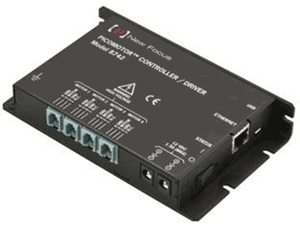
New Focus offers piezo-based nanopositioners including the Picomotor and Agilis from parent company Newport. Courtesy of New Focus.
I think electrophysiology has a long future ahead, though technology may change that: Think DNA sequencing. On the commercial side, technologies like 3-D imaging and even the use of electrophysiology will move into the pharmacological and imaging applications.
Briggs: In my perspective, the market has been at a bit of a standstill. There have been minor developments in positioning and mechanics for cryogenic and vacuum applications, as well as translation stages that are pushing the envelope in terms of precision and speed, and isolators capable of dampening even the most extreme working conditions – but these are simply improvements upon existing technology. There hasn’t been a truly groundbreaking development or release in the past few years.
Zemek: The market has become more demanding; new applications such as superresolution microscopy require more precise and stable stages. The market is heading for higher resolution, so the trend will continue to push the limits of precision and stability.
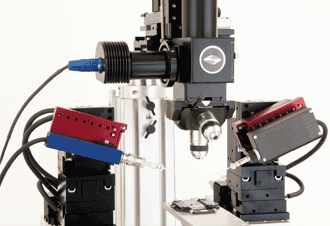
The Quad is a four-axis micromanipulator that offers drift-free fine control of electrode positioning. Courtesy of Sutter Instruments.
Cooper: Positioning instruments have become more of a commodity product as electrophysiology and microscopy have moved from pure research to being a tool used for cellular assay. Our customers now see our instruments as a means to an end and have less time to devote to learning techniques.
Ultimately, bundled systems and software with more automation will begin dominating the market.
Vorndran: We see a higher demand in smaller and higher-accuracy positioning devices.
Minty: [The market is] growing rapidly as increasingly more instruments are automated or have remote servicing and adjustment that previously required a visit from a service engineer. We anticipate continued growth as integrated adjustments come down in cost of ownership and in footprint inside.
Q: What are the biggest challenges to advances in positioning for bio?
Vorndran: Cost and size. A recent breakthrough in several piezomotor-related drive technologies allows the production of extremely small devices, with longer travel ranges and at lower cost than before.
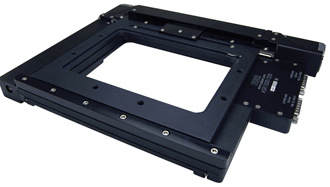
The open-loop Zaber Motorized X-Y Microscope Stage features accuracy and repeatability, as well as quick translation speed across 100 × 120 mm of travel. Courtesy of Zaber and Edmund Optics.
Briggs: There are a lot of companies working in this area, but many of the larger companies known for mechanics or positioning have other focuses. Positioning is sometimes an afterthought or secondary.
Hodge: The biggest challenges at the university level will be funding high resolution and precision for laboratory applications, as the devices required are not inexpensive. As techniques merge into commercial applications, this does change as volume goes up, but entry level can be steep.
Another challenge is precision, stability and the desired ever-shrinking size of commercial devices – there are physical limitations that, with current technology, can be major roadblocks. I still believe in our abilities to resolve these issues even with limited funding.
Minty: [One challenge is] making designers aware of the advances in the technology. It also involves looking at the overall performance advantages of precision adjustments and reduced cost of ownership vs. more expensive components upfront.
Cooper: NIH funding levels certainly are not what they were 10 years ago. In order to help customers stretch their dwindling grant money, we have tried to offer customers more flexible products with more functionality, which makes for better equipment investments.
We also have started offering bundled systems that allow us to give larger discounts and thus offer more value to the researcher.
Zemek: [Two big challenges are] thermal drift and stability over time. ASI was one of the first companies to develop a continuous reflective interface feedback focus (CRIFF) system for maintaining focus over time; this has been replaced with our CRISP system. Similar systems are commonplace today, as seen with Nikon’s Perfect Focus, Olympus’ ZDC and Zeiss’ Definite Focus. Maintaining X-Y position over time with embedded nanoparticles, or other fixed fiduciary, is a logical next step for superresolution work.
Q: And which application areas would you say are thriving – and why?
Minty: The life sciences market, because customers want lower-cost and smaller systems.
Briggs: There are a number of biomedical and life sciences applications that are demanding the most advanced positioning products. These include confocal and multiphoton microscopy, optical coherence tomography, point-source scanning systems, and various optical trapping or optical tweezer configurations. The reason for demand in these applications is the extremely high magnification and control needed to not only visualize the sample or object of interest, but to precisely control and isolate regions of interest in samples such as cells, proteins or individual chromosomes and amino acids.
Cooper: Cutting-edge techniques appear to be getting the majority of NIH funding. Scanning systems are crucial in multiphoton microscopy, which increases the depth at which scientists achieve noninvasive images of neurons in their natural environment. High-speed wavelength control is a principal requirement of optogenetics.
Vorndran: Applications related to single-molecule research. These are essential in understanding the function of the “nanomachines” inside the cells. PI is working with a number of leading scientists in this field.
Zemek: Superresolution microscopy and selective-plane light-sheet microscopy. Researchers need to image life in action, and intracellular processes require high resolution at low light levels. It is very hard to image live cells without damage – this is the trick to master.
Hodge: We are constantly looking for tabletop solutions for devices that used to fill a laboratory space. That is what is driving commercial applications using highly stable and precise devices that fit into a small space.
Positioning products
The companies consulted for this article offer the following:
• Applied Scientific Instrumentation: Ultraprecise DC servomotor and piezo stages for microscopy positioning; selective-plane and light-sheet microscopes with piezo- and servomotor control.
• Edmund Optics: A number of actuators and motorized stages for biomedical and life sciences applications that require high-precision automation and repeatability.
• New Focus: Newport’s range of piezo-based nanopositioners includes the Picomotor and Agilis, as these products provide set and hold adjustment and positioning of a few tens of nanometers for optics, specimen adjustment, and laser and fiber alignment for various biophotonic instruments.
• PI (Physik Instrumente): Piezo nanopositioning stages, nanofocus devices for microscopy, piezo ultrasonic motors and transducers, precision linear and rotary positioners, and hexapod six-axis positioners.
• Siskiyou Corp.: Submicron micromanipulators for electrophysiology and related hardware for attachment to imaging systems; monolithic flexure mounts for positioning optics in applications demanding high stability and precision.
• Sutter Instruments: Micromanipulators, including the Quad, a four-axis micromanipulator that extends the range in the X and Z planes and offers drift-free fine control of electrode positioning; microscope translation (motorized and manual); and motorized microscope stages.
Published: September 2014